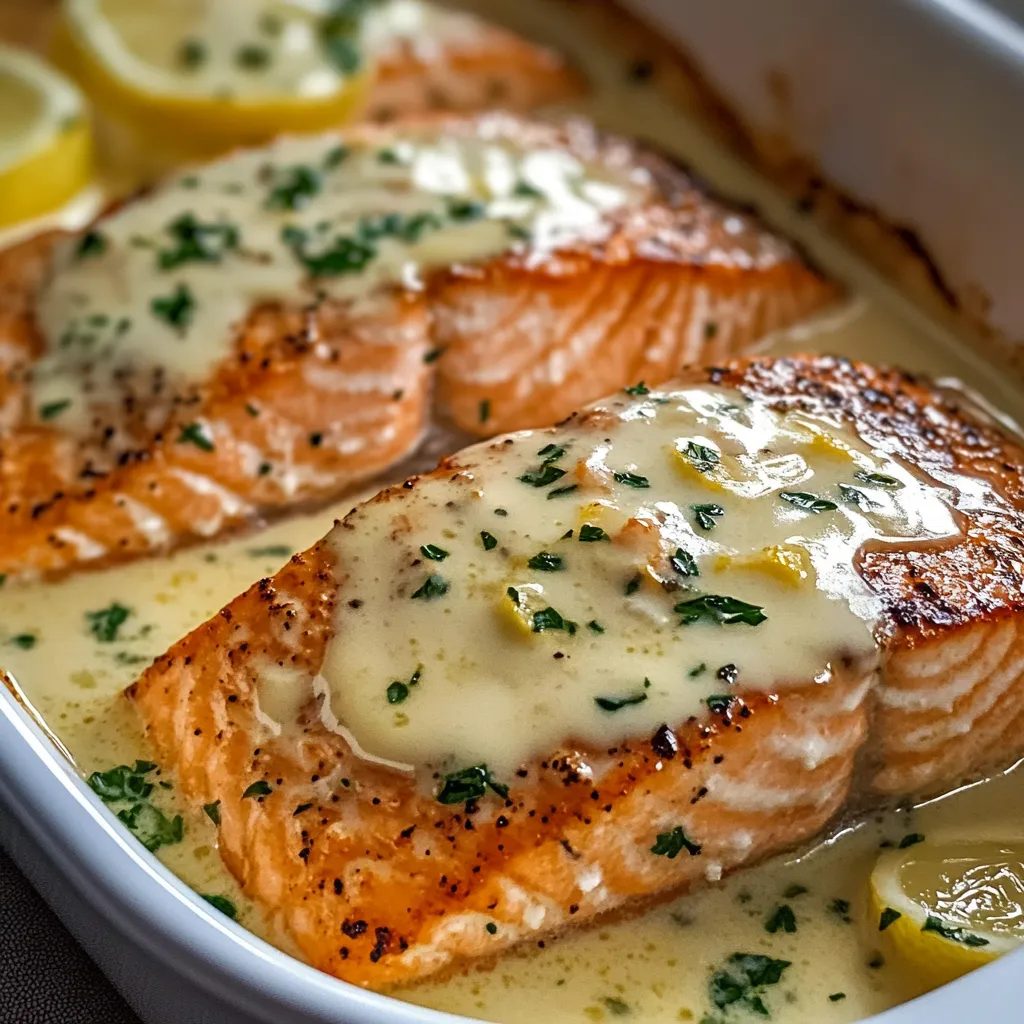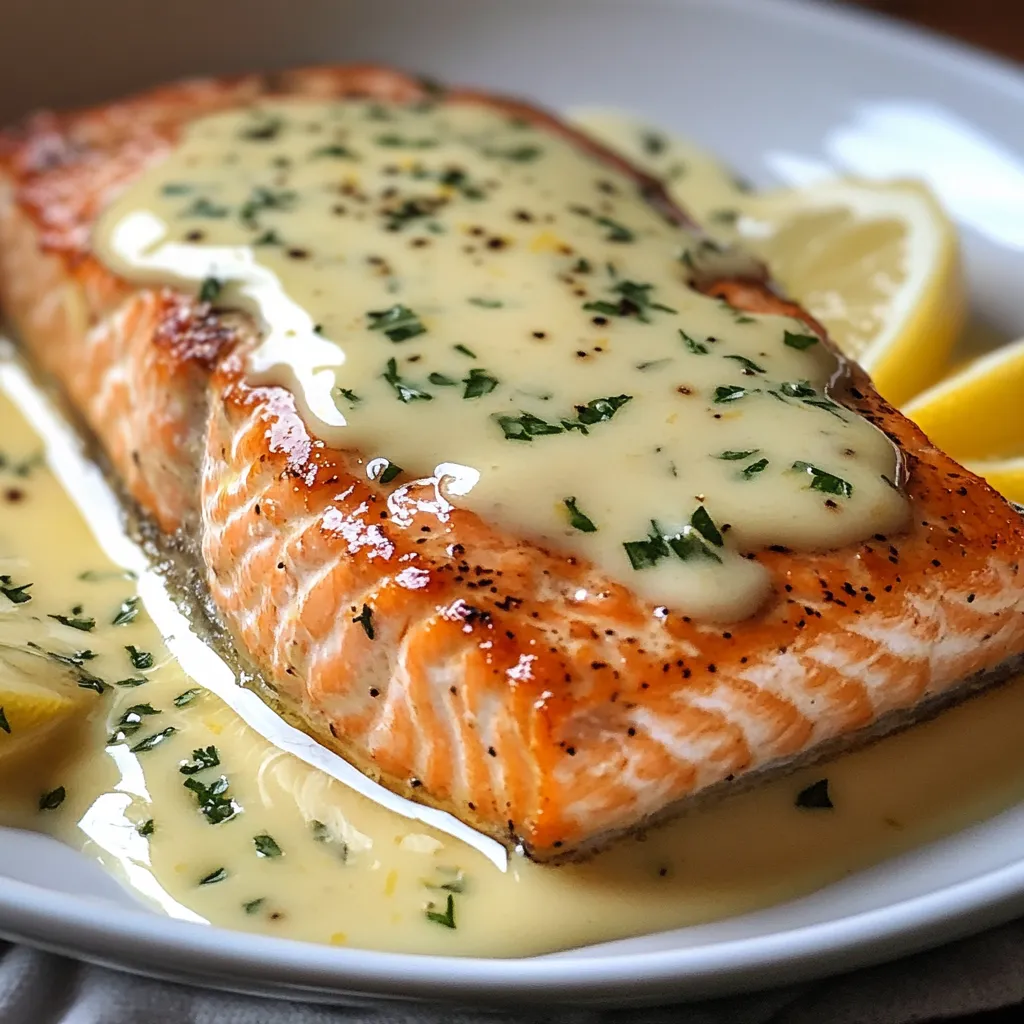 Pin it
Pin it
Salmon Baked with Citrus Creamy Butter Sauce turns ordinary fish into a fancy meal you'd think came from a high-end restaurant. The smooth, tangy sauce with fresh lemon and rich cream makes this quick dish feel extra special. Every bite of the perfectly cooked fish gets coated in that shiny, flavorful sauce. I came up with this way of cooking during my kitchen adventures trying different seafood recipes, and now everyone asks me to make it for regular family meals and fancy get-togethers alike.
I made this for a small dinner party last weekend, and nobody could believe how fancy yet easy it was. Everyone wanted extra sauce to pour over their side dishes. It's now my favorite thing to cook when I want to wow people without spending forever in the kitchen.
Smart Ingredient Choices
- Fresh salmon fillets: Go for pieces with bright color and a clean sea smell. They should feel firm when you touch them.
- Heavy cream: Makes your sauce silky and thick with amazing richness.
- Unsalted butter: Lets you control the salt while adding wonderful creaminess to your dish.
- Fresh lemons: Both the juice and zest bring brightness that cuts through the rich flavors.
- Good olive oil: A flavorful oil brings out the natural taste of the fish while helping create a golden outside.
- Fresh garlic cloves: Give much better flavor than the jarred stuff, adding wonderful warmth throughout.
- Fresh parsley: Adds a pop of green color and light herby taste that balances everything else.
Cooking Success Secrets
- Getting Ready:
- Take salmon out 15 minutes before cooking. Wipe fillets completely dry with paper towels. Set your oven rack in the middle and wait for it to fully heat to 375°F. Use a baking dish that fits all pieces without squishing them.
- Adding Flavor:
- Sprinkle plenty of sea salt and fresh black pepper on the salmon, lightly pressing it in. Let the seasoned fish sit while you make the sauce, giving the salt time to work its magic.
- Making the Sauce:
- Start with finely chopped garlic in warm oil, letting it get fragrant but not brown. Slowly pour in room temp cream while constantly stirring. Add lemon juice bit by bit while whisking so it won't curdle.
- Putting It Together:
- Put your seasoned salmon in the dish, skin down if it has skin. Pour the yummy sauce over each piece, making sure they're all covered. The sauce will bubble and get slightly thicker while baking, creating a beautiful coating.
 Pin it
Pin it
Coming from a family that always enjoyed seafood, I learned early on that salmon needs gentle handling. This recipe sticks to that idea while adding just enough luxury to make it feel extra special.
Tasty Side Dish Ideas
Make this salmon into a full meal with the right sides. Soft jasmine rice soaks up all that amazing sauce, and steamed asparagus adds nice crunch and color. If you want something lighter, try it over some wilted spinach or next to roasted Brussels sprouts. The sauce tastes great with any veggie, so you can switch things up based on what's in season.
Fun Variations
Try this dish different ways by changing up the flavors. Add fresh dill and capers for a Nordic twist, or mix in tarragon for a French feel. Make it Mediterranean with dried tomatoes and basil, or try white wine and shallots for more depth. Each change opens up new pairing options while keeping things simple and elegant.
Storing Leftovers
Keep leftover fish and sauce in separate containers that seal tight. The salmon stays good for about two days in the fridge. When reheating, let both parts come to room temperature first. Warm the fish gently in a 300°F oven while slowly heating the sauce on the stove, stirring often so it stays smooth.
Watching Your Heat
Knowing how your oven works helps get perfect results. Starting at 375°F gives gentle heat that keeps the salmon juicy while thickening the sauce just right. Look for visual clues: the fish should look just opaque and flake easily with a fork. A tiny bit of shine in the middle is perfect, as it'll finish cooking while resting.
Getting Sauce Right
Making a perfect sauce needs careful attention. Start with cream that isn't cold to prevent breaking. Pour in lemon juice slowly while constantly whisking. If your sauce gets too thick, add a splash of warm water or broth. The final texture should coat a spoon but still be easy to pour.
Perfect Salmon Texture
Getting salmon cooked just right comes down to timing. The fish should be barely opaque and flake with light pressure. Don't overcook it, or it'll turn dry and crumbly. The sauce helps keep moisture in, but getting the right temperature and timing matters most.
After trying countless salmon recipes over the years, this method always gives amazing results. It brings together easy cooking with fancy presentation, making it right for any meal. The sauce combines old-school French cooking with modern simplicity, creating something that feels fancy but approachable.
What makes this recipe so great is how flexible and reliable it is. Whether you're making dinner for the family or hosting a special event, this salmon dish delivers both comfort and elegance. The mix of perfectly cooked fish and silky sauce creates a meal everyone will remember and ask you how to make.
 Pin it
Pin it
From my home cooking to yours, this dish shows how simple ingredients can become something special. It proves that with good ingredients and proper technique, you can make restaurant-quality food right in your kitchen. The way the sauce highlights the salmon's natural flavors while adding its own luxurious touch makes this recipe stand out from all the others I've tried.
Frequently Asked Questions
- → Which salmon type works best?
- Both wild and farm-raised salmon will work. Go for center-cut pieces to ensure even cooking.
- → Can this meal be prepped early?
- It's best enjoyed fresh, but you can make the sauce ahead of time and reheat it before baking the salmon.
- → What sides taste great with this dish?
- Pair it with roasted veggies, salad, rice, asparagus, or even pasta for a complete meal.
- → How do you check if salmon is cooked?
- The fish is ready when it flakes easily with a fork and hits an internal temperature of 145°F (63°C).
- → Is there a cream alternative?
- You can sub in half-and-half, though the sauce might be thinner. Avoid milk as it won't yield the same creamy texture.
